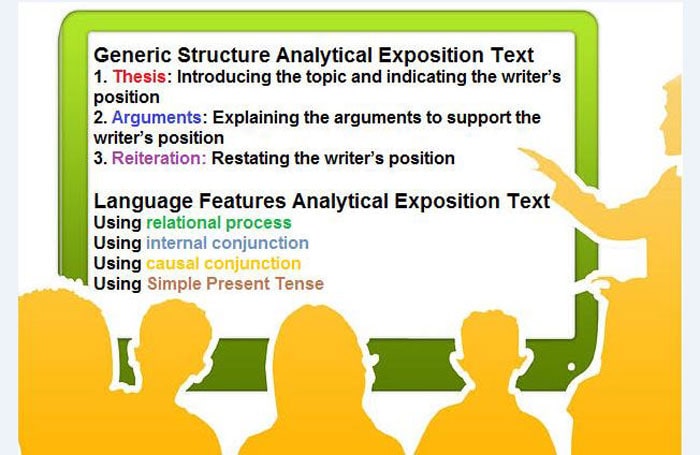This time we will learn about Analytical Exposition Text, in English class XI there is a discussion of analytical exposition sentences. Have you ever heard or read sentences that contain opinions? For example, this sentence, “Do you agree that exercise is an impoertant things in our live now? Yes, I do, the exercise has an important role in our live to day”.
This sentence in English is called Analytical Exposition. For more details on the meaning of Analytical Exposition and its explanation, let’s see the review below.
Definition of Analytical Exposition
From the above understanding, we can understand that analytical exposition is a sentence that contains the thoughts of a writer about things that happen in his environment, whether it is related to objects, activities, or places. A sentence like this is also called argumentative text because it shows an opinion or reason about something that happened.
The function of this sentence is to convince the reader about what is happening or the topic that is being discussed. However, in this case, the sentence exposition or analytical exposition does not become a sentence that changes the reader’s thinking, it is only a sentence that contains the opinion of the author.
Analytical Exposition Text Structure
Here we will discuss the structure of the analytical exposition text, so that with this discussion it is hoped that the reader can understand and know how to make the correct analytical exposition text. Ok, let’s see what the arrangement is and how it is formed.
Expositional analytic technique consists of thesis, argument and reiteration or conclusion. Here we see one by one.
1. Thesis
Here, the writer must inform and make the reader understand about the main topic being discussed. So, the thesis is always in the first paragraph. In this paragraph, readers can also understand why the author provides his opinion and opinion on the topics discussed.
2. Argument
You can find arguments or reasons in the next paragraph, in this paragraph the author will state the reasons why it can support the topic or discussion in the first paragraph. Usually in an analytical exposition text, the writer puts forward more than two reasons why he talks about the discussion. The more reasons that are put forward, the more interesting the analytic exposition sentence will be.
In other words, the more arguments, the more it shows that the topic being discussed is important and needs to be considered together.
3. Reiteration or conclusion
Conclusion or conclusion is a sentence that is at the end and of course is in the last paragraph. The conclusion sentence serves as the closing of the discussion. Here contains reaffirmation of the author’s opinion on the main topic.
To better understand analytical exposition text, let’s look at an example in the following sentence which consists of the three structures above.
Linguistic Rules in Analytic Exposition Text
In studying analytical exposition, it is not only the composition and structure of sentences that we must know but there are other things that we must also learn. Another thing that we have to learn is the language features or language or the language rules in the sentence.
Also read: Contoh NARRATIVE Text
Following are the rules and rules of language in analytical exposition text:
- In writing analytical exposition sentences, we use the simple present tense
- We use sentences that can express the author’s thoughts, so usually we use sentences such as feel, experience, know, sense, realize, think, etc.
- In making analytic exposition sentences we use internal conjunctions or connecting sentences. This connector sentence usually connects the argument with the clause. We need to know that the internal conjunction is divided into four parts, namely: (1) Addition or addition, for example: besides, in addition, further. (2) Comparisons or comparators, such as vice versa, but, meanwhile, on the other hand. (3) Time, for example, is the sentence then, second, then, and next. To (4) Cause-effect and examples are: as a result, consequence, so, the result.
- In writing, he also uses the sentence causal conjunctions (reason – why), namely cause and effect. Examples are because, as a result, by, despite, consequently, due to, for that reason, etc.
How? Make it easy, if you take it slowly and apply it to the examples, you can do it. Ok, that’s a complete explanation of analytic exposition text and examples, hopefully it can be useful and increase our knowledge.
Also see: Human Anatomy: Systems and Structure of the Human Body
